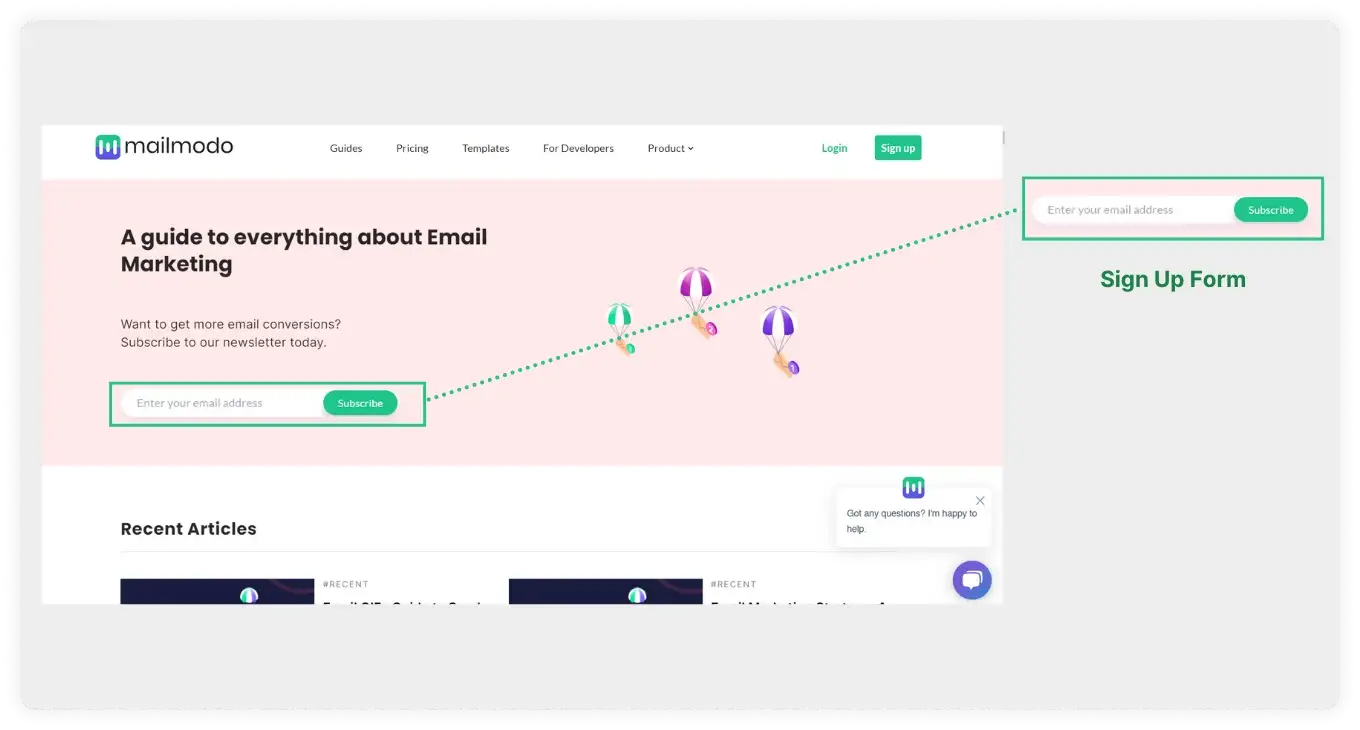People get numerous junk emails every day that they didn't ask for and spend precious time deleting them each day. The least you can do as a company is to not add to their inbox by sending such unsolicited emails and respect their time and privacy.
And that is where you can use opt-in email marketing. It is a marketing procedure where you get consent from people before you send them any emails. Here we will tell you about opt-in and how you can incorporate it into your email in your 2022 marketing campaigns.
Table of contents
What is opt-in email marketing?
Opt-in email marketing, also called permission marketing, is a marketing approach where companies ask people permission before sending them any content through emails. The word opt-in here refers to people having voluntarily 'opted in' or signed up to receive emails from your company or brand.
Companies will have areas where people can give their email addresses and sign up to join their email lists in this marketing approach. Then, they will send emails only to those people, be it promotional emails, newsletters, transactions emails, etc.

What are the different opt-in methods?
There are primarily two different types of opt-in available for email marketing: Single and double opt-in.
Single opt-in ☝️
Single opt-in is when people submit their email ids in a signup form and join your email list with that one step.
It's an easy process that is used by most companies who want to adopt opt-in email marketing. Since the process is so simple, you can grow your email list quickly from scratch.
Double opt-in ✌️
Double opt-in is when you send your subscribers an email to confirm their subscription after they have signed up with their email address.
So you can send an email saying, "Hi, thank you for joining our email community. Take a second to confirm that you would like to receive emails from us by clicking on the link below." Sending this confirmation email can be automated if you use an ESP to send out your email campaigns.
Benefits of using opt-in email marketing
Providing an opt-in method in your email marketing strategy has several advantages, which are listed below.
✅ You are less likely to end up as spam or get blacklisted
You will be sending emails to people who have signed up for them and want to receive them, so it's less likely that they would report your emails as spam. Getting marked as spam once or twice may not be harmful, but if there is a high rate of spam complaints, you'll get blacklisted.
If you do get blacklisted, your emails will go directly to people's spam rather than their inboxes. And the process of removing yourself from blacklists will be very tedious, so it's best to aim not to reach that point in the first play.
Related guide: How to Avoid Email Blacklisting?
✅ You can build a dedicated following
If you use an email list with a random email address collected from the internet to send cold emails, their chances of being your intended target audience are minimal. So most of the people in those random lists may not find your content valuable to them.
But if you use the opt-in method, the people sign up because they want to know more about you. So you'll find that you have a dedicated audience who will be more engaged with your brand and more likely to become a potential prospect or repeat customer.
✅ It helps you avoid any legal issues
In some countries, the opt-in option is the basic necessity for businesses there, and not having the choice can lead to serious legal issues.
For example, in Canada, the digital and email marketing means are overseen by Canadian Anti-Spam Legislation (CASL) , requiring a specific opt-in option to send emails to Canadian users. Similarly, the GDPR laws regulate how companies use people's information and protect them from being misused in the E.U.
✅ It is the ethical and human thing to do
Using the opt-in approach, you will be sending emails to only those who want to receive them and permit you to send them. It respects people's time and ensures that you respect their privacy by asking for consent before sending them your emails.
How to use opt-in in your email marketing strategy?
To incorporate opt-in into your email strategy, all you need to do is provide a choice to people to either join or not join your email list. And, there are several ways you can give this choice to people, and they are given below:
Signup form 📋
A signup form is a place on your website where people can submit their email ids to sign up for your email list, and it's pretty straightforward as that. And there are two things you need to state when you collect people's email addresses, and that is:
What types of emails are the subscribers signing up for?
How often will they be getting emails from you?
This will make sure that people have a clear understanding of what they are getting into.
Re-confirmation email 📧
If you have collected people's email addresses with their consent, but it has been a while since you sent them any emails, send them an email asking them if they want to receive emails for you or not.
This confirmation will ensure that people are not confused by why they are suddenly receiving emails from you. Also, it'll help them know what they'll be getting and thus not mark you as spam.
Regular email 📨
If someone has subscribed to your newsletters and you want to send them promotional emails, then add a section at the end of the newsletter to provide them the option to opt into it.
You can write, "Hi, hope you liked this week's newsletter; if you would like other emails from us, then click here."
Incentives 🎁
If you provide a valuable incentive to people, they will gladly submit their email addresses to get it. Such incentives are also known as lead magnets and will usually be provided to people after they sign up with their email addresses.
In the example below, Marketo has added a signup form to their lead magnet landing page to encourage customers to provide their email ids to get the report.

Related guide: How to build your email list.
Best practices to follow for incorporating opt-in in your email strategy
Now that you are aware of the basics of how to use opt-in in email marketing, here are a few recommendations and best practices that you can follow to get the most out of your opt-in approach.
Keep the signup form short 🗳
Sign up is, in a way, a barrier that people have to cross to access some content like a newsletter or freebie that you provide.
So you need to keep this barrier small so that people don't lose interest and leave, and to do that, keep it to only one element (their email id) to sign up. And, if you want more details about them, you can get it later on with forms in the future.
Send emails regularly 📬
Regular emails will make sure that they don't forget about you and accidentally mark you as spam. So, firstly always send some thank-you or welcome email as soon as they enter your email list. Then make sure to send them emails regularly, be it daily, weekly, or monthly.
Read about - A Guide to Finding the Right Email Cadence for Higher Engagements.
Permit subscribers to opt-out 👋
While talking about opt-in is necessary, opt-out is just as essential. And if you already have a list of subscribers you send emails to, then providing an easy unsubscribe button can give them the option to leave or stay subscribed.
Learn more about email unsubscribe from our guide - 11 Most Effective Ways to Reduce Unsubscribe Rate.
Allow subscribers to manage their preferences ✅
If the users don't want to unsubscribe completely, they can use the update preferences option to choose what to receive. It will show your subscribers that you value their opinion to choose what they want and are not at your mercy.
It's not a guarantee that you won't have any spam complaints but just one less reason why one might mark you as spam.
Read in detail: How to Create Powerful Preference Center to Retain Your Valuable Subscribers.
Conclusion
Building an audience with an extra opt-in step can be tedious but worth it in the long run. It'll help you get a more dedicated audience who could potentially buy your products or services, which is what matters.
So use opt-in in your marketing strategy to build your email lists the right way to grow a genuine community.


